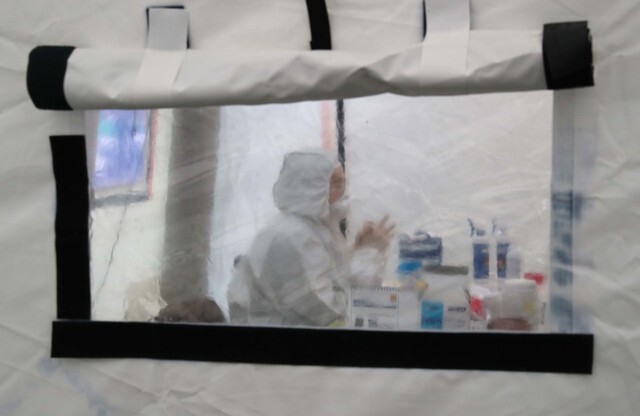hankyoreh
Links to other country sites 다른 나라 사이트 링크
S. Korean government covers costs for testing for and treating coronavirus infections

After a recent trip to China, Kim A-yeong (pseudonym) came down with what seemed like a nasty cold. Wondering whether she might have contracted the coronavirus (which causes the disease now known as “COVID-19”), she visited a public health center designated for testing and she provided some phlegm as a sample. After testing positive for the virus. Kim was hospitalized at one of the government’s quarantine facilities and then released two weeks later.
How much does Kim have to pay for her testing and treatment? The answer is “nothing” Under the Infectious Disease Prevention Act, the South Korean government is covering all costs related to testing, quarantine, and treatment for COVID-19. More specifically, the cost is shared by the National Health Insurance Service (NHIC), the state, and local governments.
The initial cost of collecting a sample and testing it for the coronavirus is about 160,000 won (US$135.28). An individual identified as a “suspected patient” under the standards announced by Korea Centers for Disease Control and Prevention (KCDC) is completely covered by the national health insurance and doesn’t incur any out-of-pocket expenses.
A suspected patient is defined as someone who exhibits respiratory symptoms, such as fever and coughing, within 14 days of visiting China or coming into close contact with an infected individual showing symptoms of the disease. Someone who experiences those symptoms within 14 days of visiting a country other than China where coronavirus transmission is believed to be occurring at the local level can also be categorized as a suspected patient at the discretion of a doctor. However, government support only applies to the cost of collecting the sample, and the patient is still responsible for fees associated with a standard examination and other procedures, such as X-ray testing.
After an individual is definitely diagnosed as being infected, the government covers all costs resulting from treatment, testing, and examination from the time of their admission at the hospital until the time of their release from quarantine. The cost of medical care is divided as follows: the NHIS pays hospitals what it would normally pay under insurance rules, while hospitals will be reimbursed for the patient’s treatment copay and other costs incurred during hospitalization, including meals, by the KCDC, local governments, and public health centers. For humanitarian reasons, the government has also decided to cover the testing and treatment costs for foreigners even if they aren’t enrolled in the national health insurance scheme.
The government will also be covering part of the costs incurred by individuals who haven’t tested positive but have to undergo a 14-day quarantine at home after coming into contact with an infected individual. Individuals who have been ordered to go on self-quarantine will be paid 1.23 million won (US$1,040; assuming a family of four), while companies that provide paid leave to individuals on self-quarantine will be compensated up to 130,000 won (US$109.94) per day.
By Park Da-hae, staff reporter
Please direct comments or questions to [english@hani.co.kr]

Editorial・opinion
![[Column] Season 2 of special prosecutor probe may be coming to Korea soon [Column] Season 2 of special prosecutor probe may be coming to Korea soon](https://flexible.img.hani.co.kr/flexible/normal/500/300/imgdb/original/2024/0426/3317141030699447.jpg) [Column] Season 2 of special prosecutor probe may be coming to Korea soon
[Column] Season 2 of special prosecutor probe may be coming to Korea soon![[Column] Park Geun-hye déjà vu in Yoon Suk-yeol [Column] Park Geun-hye déjà vu in Yoon Suk-yeol](https://flexible.img.hani.co.kr/flexible/normal/500/300/imgdb/original/2024/0424/651713945113788.jpg) [Column] Park Geun-hye déjà vu in Yoon Suk-yeol
[Column] Park Geun-hye déjà vu in Yoon Suk-yeol- [Editorial] New weight of N. Korea’s nuclear threats makes dialogue all the more urgent
- [Guest essay] The real reason Korea’s new right wants to dub Rhee a founding father
- [Column] ‘Choson’: Is it time we start referring to N. Korea in its own terms?
- [Editorial] Japan’s rewriting of history with Korea has gone too far
- [Column] The president’s questionable capacity for dialogue
- [Column] Are chaebol firms just pizza pies for families to divvy up as they please?
- [Column] Has Korea, too, crossed the Rubicon on China?
- [Correspondent’s column] In Japan’s alliance with US, echoes of its past alliances with UK
Most viewed articles
- 1‘We must say no’: Seoul defense chief on Korean, USFK involvement in hypothetical Taiwan crisis
- 2N. Korean delegation’s trip to Iran shows how Pyongyang is leveraging ties with Moscow
- 3[Column] Season 2 of special prosecutor probe may be coming to Korea soon
- 4‘Weddingflation’ breaks the bank for Korean couples-to-be
- 5[Column] Has Korea, too, crossed the Rubicon on China?
- 6[Editorial] New weight of N. Korea’s nuclear threats makes dialogue all the more urgent
- 7[Reportage] On US campuses, student risk arrest as they call for divestment from Israel
- 8Korea sees more deaths than births for 52nd consecutive month in February
- 9[Column] Park Geun-hye déjà vu in Yoon Suk-yeol
- 10[Guest essay] The real reason Korea’s new right wants to dub Rhee a founding father